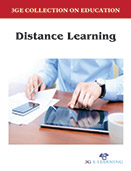Education and Psychology

Distance learning is an increasingly popular and practical alternative to standard classroom training. Universities have long experimented with different learning environments to accommodate the needs of their students. Along with the traditional classroom, we have seen the use of correspondence courses, courses on tape, televised courses, and most recently internet based distance education. Distance Learning is an instructional delivery program that associates learners with educational resources. Distance Learning provides educational access to learners not enrolled in educational institutions and can expand the learning opportunities of current students. The implementation of DL is a process that uses available resources and will evolve to incorporate emerging technologies. Distance learning traditionally has provided access to instructional programs for students who are separated by time and/or physical location from an instructor. It has been thought of as prepackaged text, audio, and/or video courses taken by an isolated learner with limited interaction with an instructor or other students. This perspective is changing. Today information technologies and the Internet can allow rich interactive distance learning experiences that may surpass the interactivity of a traditional classroom. Distance learning can be provided in several contexts including stand-alone distance learning, blended learning where the student participates in a regular class and distance learning class concurrently, and hybrid learning where distance learning supplements classroom instruction.
Distance Learning focuses on the processes, techniques and tools that are being used to successfully plan, implement and operate distance learning projects. This volume provides comprehensive coverage of the issues, concepts, trends, and technologies of distance learning. It is equipped with the best fits of distance learning technologies for the teacher and learner presented by sharing teacher experiences in information technology education. Education can become transformative when teachers and students synthesize information across subjects and experiences, critically weigh significantly different perspectives, and incorporate various inquiries. Educators are able to construct such possibilities by fostering critical learning spaces, in which students are encouraged to increase their capacities of analysis, imagination, critical synthesis, creative expression, self-awareness, and intentionality.
This book will help you address that daunting challenge, examining ways to assess user needs, to develop and offer well-thought-out information literacy courses, to employ appropriate teaching methodologies.